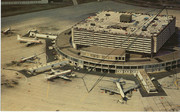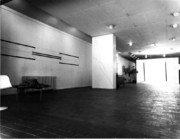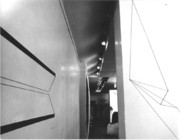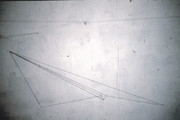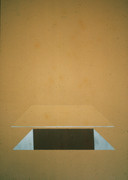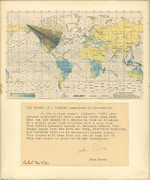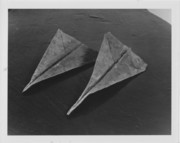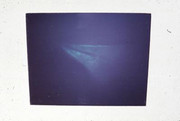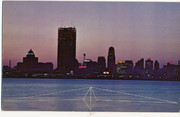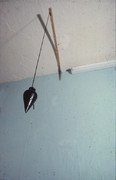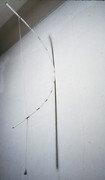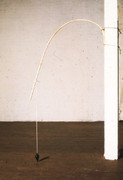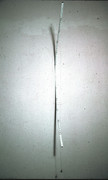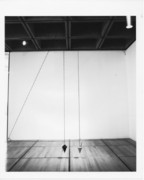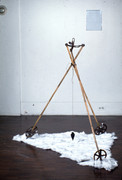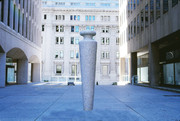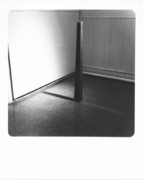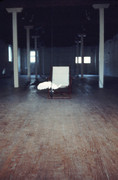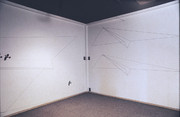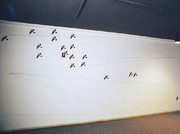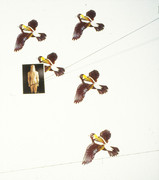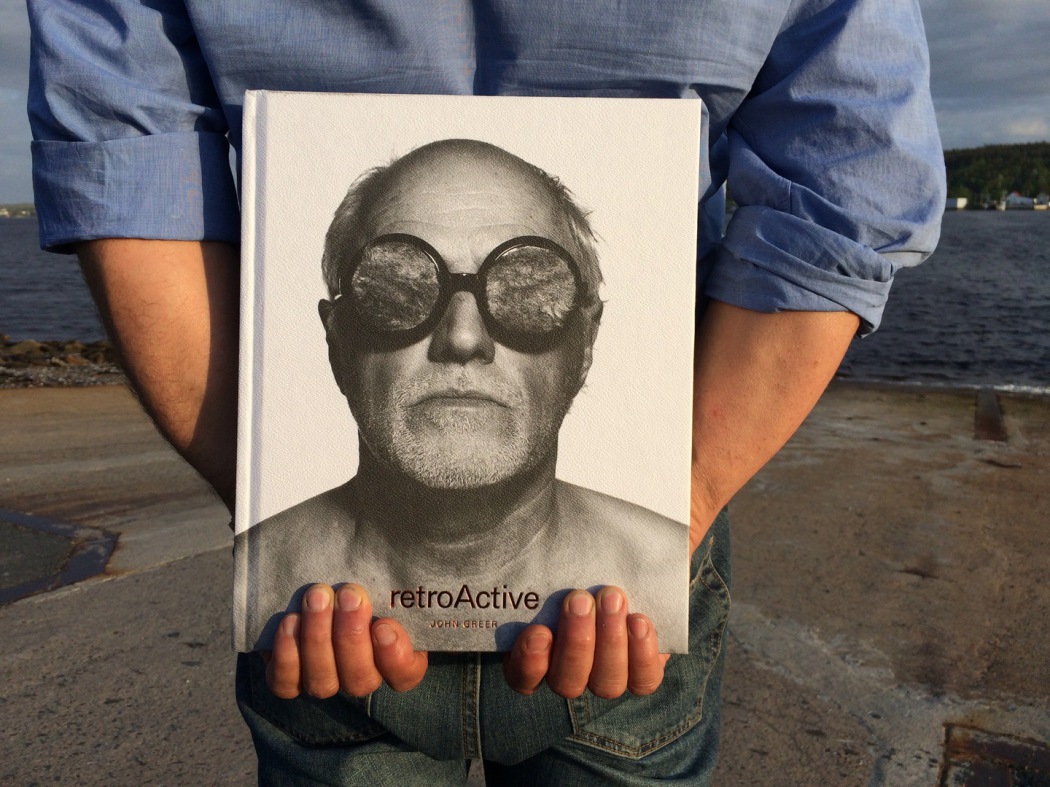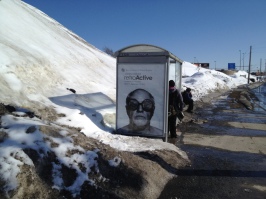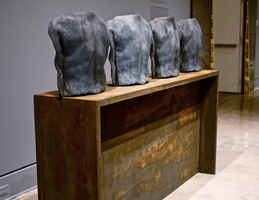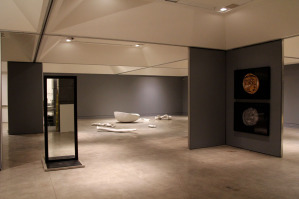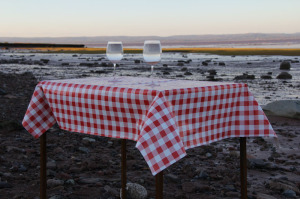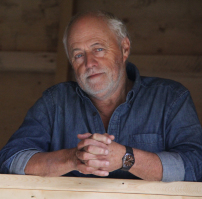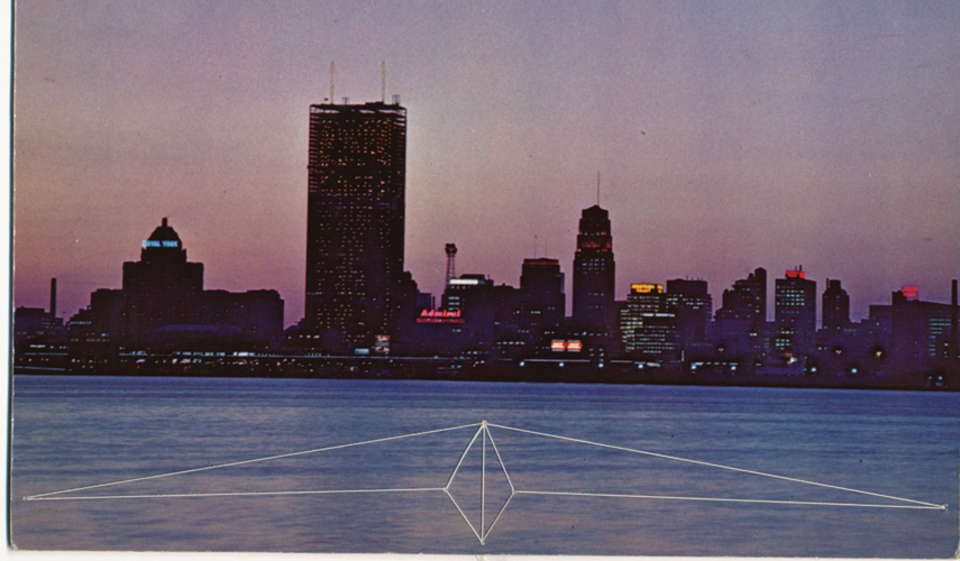
Mental Devices - Physical Grounding
In 1970 John Greer realized the show “Suspension-Tension” at the Isaacs Gallery in Toronto. It consisted entirely out of black elastic string that was nailed to the walls and between walls. With three-dimensional lines the artist formed illusionary plains, suggesting three-dimensional space by using linear perspective and three-dimensional images of paper-airplanes (the ones that everyone folds in his childhood in order to escape the boredom of a class at school).
With this exhibition, Greer starts his adventure into the world of three-dimensionality - drawing in space. The “double-entendre” that he is taking up here, is, in all its subtlety in appearance, a radical step in criticizing the limits of an image and in the attitude of dealing with it. Greer proposed an extension of perception by responding to the viewer’s mental flexibility.
One of the last paintings that Greer did stands in close proximity to the new works; marking a preoccupation with the limits of depiction. The “Hole in the Desert” 1968 is a yellow-ocher coloured picture plane. A rectangular space is opening into the ground, the ceiling or lid of that room under the earth appears to be floating right above it, leaving a gap that is big enough to let us peep inside. Painting is here a way of illustrating an idea, documenting an idea, (suggested) space is established inside of (suggested) space, colour and line stand for material, the artist is intellectually bridging in order to surpass the limits of the picture plane. What Greer calls his “frustration” was a dilemma that had to be surpassed by a lot of artists in North America at that time, which took up different radical stands; a specific sensibility grew out of the sixties and reacted towards a “traditional” understanding of painting and sculpture. Artists like Frank Stella and Donald Judd were the spokesmen for a thinking that would lead to what was called Minimalism, and towards Concept Art. It is important to understand the discrepancy in the basic thinking that puts Greer in opposition to the minimal tendencies. In contrast to the “coolness” of Stella’s remark on painting: “I always get into arguments with people who want to retain the old values in painting - the humanistic values that they always find on the canvas. If you pin them down, they always end up asserting that there is something there besides the paint on canvas. My painting is based on the fact that only what can be seen there IS there. It really is an object.”15 and the general understanding of the process of art by Judd: Barbara Rose wrote that his “rejection of illusionism is deeply rooted in the pragmatic tenet that truth to facts is an ethical value. For Judd, illusionism is close to immorality, because it falsifies reality. Things must be as they appear to be. Pragmatism equates truth with the physical facts as experienced” Judd himself remarked: “A shape, a volume, a color, a surface is something itself. It should not be concealed as part of a fairly different whole. The shapes and materials shouldn’t be altered by their context.”16 Greer is not criticizing a humanistic or, as one might call it, anthropomorphic approach in art. Greer’s approach is in fact more of an extension of a humanistic point of view. He uses man as measure for things - and is speaking for individuality, meaning that everyone is the center of his own universe. Events and actions are meaningful so that there is a belief in transcendence. For Greer objects are things in themselves, but he is, in contradiction to Judd, accepting that things (shapes and material) are constantly altered by their context. Greer sensitizes the viewer for this complexity of meaning by using everyday materials in witty and humorous constellations.
Greer stepped out of the picture plane and used real space as ground for drawing. As for many other artists, the representation of things by using canvas and paint did not satisfy the growing engagement for art as a relevant timely concern. A lot of the work that Greer realized in the late sixties and early seventies is located around this act of “stepping out”.
It is interesting to observe that he was still investigating illusionary space and was putting that next to his first artistic insights into what physicality and gravity means. The elastic cord is used as line in space, suggesting form and motion that was to be completed by the mind. In a catalogue for a show in 1974 at the Killam Art Gallery in Halifax, NS, he writes as notes concerning the airplanes, which he would call as well “Illusionary Planes”: “Three-dimensional space is THIS space or the space you are in. All the airplanes in THAT space can be “flipped” that is, “change direction at the viewer’s will.” Without a visible horizon, you can view the planes from above and down below. The ability to do this is vital to the manipulation of the airplanes in THAT space. Your mind is the control tower. The planes can be any size you wish, depending upon the distance at which your mind places them from you; and they can be moved by mentally projecting them away from you, or drawing them towards you. Remember this is all mentally controlled; the actual size of the airplanes does not change. One design shows an airplane passing over a trench or hole. The trench can be either a “vacuum” sucking air in or a “blower” blowing air out.”(John Greer)17 He mentions the mind as our “control tower”, thus regarding his “drawings” as situated in a dimension that is connecting us and our space to what he calls “that” space, the non existing, but mentally implied idea of space. The engaged viewer was actively included in the gallery space - the experience of the art event was taking place inside of the head of everyone for himself. The spectator was literally included in the picture-plane, like the prey in a spider’s web, with the difference, that one had the cords in one’s own hands, or better in the head. Greer took literally an advice by a Sculptor and Professor from Munich from 1950: “I would have all art students learn “gliding” for the first two years, so that they do not believe in “form” and are supported by and in air, without trying to shape it.” (Karl Knappe)18
With the airplanes Greer invites the viewer to accompany him during his lesson, giving us an intellectual device in order to fly in space and let form become a mental device by using our head as a tool.
This is an approach beyond painting, resting in a position that is somewhere between the reflection on the self-sufficiency of objects as things in themselves and an approach that denies the object in favour of an idea or a concept. The artist uses real space to draw in and makes us do an exercise, physically training our brain.
He extended his illusionary picture plane in a project with the title: “Six points of a Shadow”. “It was in 1969 or 1970 I did this piece; Post.-marker cards were sent out to myself General Delivery to 1.Wainwright, Alaska 2.Hebron, Labrador 3.New York, New York, 4.Baltimore, Maryland, 5.Richmond, Virginia and 6.Vera Cruz, Mexico. They were held for 15 days and then came back to me. This illusionary continental airplane materialized for a brief period of time.” (John Greer)19
He drew a paper airplane on a map and projected the fixing points of the drawing into reality by using the marked cities on the map for a gigantic illusionary/real plane. The work is realized as a concept through its physical completion.
In 1978 the artist follows the insight into his flights of thought from the opposite point of view. He folded paper-airplanes out of sheet-lead: “Lead to Belief” 1978, “The weight is a very important factor. Flight is beyond unassisted human capability. The common image and size make flight seem possible. This piece is dealing with solid associations controlling anticipation or perception.” (John Greer)20 The size and the shape of the forms suggest the possibility of flight, but they do not fly if you try to give them a start. So they signify the discrepancy of a mental construct and its reality by the choice of material. Material forces govern our ideas. In order to show this duality of being and thinking, Greer looked into the medium of holography and added another physical statement in 1979: “A little more Weight”, 1979, “The image of the lead airplane passes through the picture plane” (John Greer)21 The hologram is a medium that is tempting the dimensions. This is a physical statement of the more complex and much more vital examination that he undertook in 1970, using the same imagery that established a position in the search of the “real” space and its artistic definition.
With the elastic string John Greer found a medium that helped to visualize the questioning that was surrounding his “stepping out”. He used it as a connecting element, visually - to start a projection of thought, formally - to represent shapes, and as physical devices, simply in order to fix and connect things that he used in the installations.
The plumb bob was an object that he started to use in the early seventies. A signifier for mass and physicality, it is a device for us in order to project our thinking into reality (meaning the surrounding world) and by that, relocate the body awareness, thinking about feeling, feeling about thinking.
At that time Greer is about to find out what gravity means for him and tries to visualize this force through casual encounter. He uses a plumb line, which is a means for measuring things; it assists in finding out whether things are exactly vertical or true. Through the gravitational force, the plumb line is directed towards the center of the earth and manifests therefore this force, which is grounding every thing and every person.
“Iron Plumb” 1968, consists of a plumb bob hung from the end of a yardstick which in turn is fixed against the ceiling of a room. By the weight of the iron, the yardstick is pulled down, so that the length of a yard is not any more measurable at the ceiling, but measures into space, shortening the distance on the plane of the wall/ceiling. It is not that you would not know..., theoretically, practically we see that our projection of space does not work any more, as soon as it is connected to reality! “Lead Dance” 1970, is playing with the whole length of a rule, contracting measurement of space through tension. The “Dancer” 1971, a plumb bob tightening a bamboo rod from a buttress is playing with the gravitational forces inside of the room, so that every tremor of the floor by walking on it causes a vibration in the fragile tension of the construction. Another work “untitled (plumb bob)” from 1971, is tempting the measuring of forces, by visualizing 25kg of weight and 25kg of tension, one being a scale which is holding a plumb bob, the other a scale tightened between two opposite walls in a room. This piece brings gravitational forces into our consciousness, using the whole architectural space as room for the sculpture. “Beyond a shadow” 1981, is a work that was realized 10 years after the first experiments with plumb bobs. The scale of the work was shifted from casual encounter towards an obvious confrontation. The rope connection of the plumb bobs, one cast iron, the other willow wood, hanging next to each other from the ceiling, was continued in order to fix one wall through an imaginary diagonal from floor to ceiling. It built up a wall-picture-plane, yet was defining gravitational forces of the whole space. The work made the viewer realize the direction towards the center of the earth, which is tempting our understanding of parallel lines, since they are really not. The proximity of a wooden model to a cast iron original gives an impression of what weight means, because of the different tension of the two ropes. The means of measuring become obvious as mere model for real spatial forces through a simple device, a sign for measure.
These Duchampian gestures define the proximity of thinking to a total investment in art as a language that wants to deny historical documentation and is beyond an exact definition of what art should look like. The artist is questioning the arbitrary act of an artificial arrangement that is reducing meaningful subjects to a measurable quantity. Yet Greer is not using methods of chance or indifference but mediums that signify real space in vicinity to mental devices, which are so often mixed and falsified.
“A Little White Lie” 1972 is playing with the idea of a mental construct becoming truth through belief. In a note the artist describes the object as a facsimile of two apparatuses that are currently set up at each of the poles, which is a plumb bob hanging from the fixing point of three ski sticks holding each other up. The idea is the definition of the worlds gravitational axis, creating the slowest spinning in itself of the plumb bobs that is possible on earth. This work is like a theorem on gravity, it works as a mental device.
The plumb bob becomes a tool for many of his works and culminated in a statement of a monumental earth-connected granite-shape with “Plumb” 1988. Here Greer sums up the importance of the ever-present gravitational encounter. In 1978 he made his first sculpture - as opposed to object installations: “Stone”. Its shape is reminiscent of a plumb bob put upside down. In a statement Greer notes: “This piece is in part dealing with the equilibrium between material and vision. The stone’s shape itself is somewhat paradoxical. Your vision is attracted down to the mass when the natural inclination is for your vision to float upward, thus causing a visual resonating quality between the viewer (vision) and the stone (material). The age of stone, as well as its agelessness should be considered.” In this work Greer is playing with the attraction of physical commodities and visual phenomena in the relation between a person and a confronting object. Through its simplicity the work is charging the space and the viewer’s resonance to a familiar yet unfamiliar form. Later on Greer is continuing to use this specific shape and size in order to relate to the viewer’s physicality and location in space. It becomes a component of a direct visual language with the purpose of engaging the viewer in a meaningful encounter.
The plumb bob was also an incentive for the investigation of the mental constructs of a physical being, in the way that the fixation on physical facts is the basis for our fictitious flights and dreams.
“As the crow flies” 1971“This plumb-feather apparatus, attached to the ceiling by an elastic cord, is released by the sitter. The feather does a very organic dance and the viewer’s depth of focus is precisely controlled. Time: about 15min.” (John Greer)22 This work visualizes this process, or better makes the viewer/sitter active part of the experience of a projection and the repulse on the person. A chair is placed in proximity to a swinging plumb, fixed to an elastic cord. Two feathers are fastened like wings at the object. With the heavy up and down movement of the plumb, the feathers start to dance around the center. Sitting in the chair you are seduced by the movement and flow, “mentally flying” with the object, but the short distance to the swinging mass keeps oneself in a tension: you do not get used to the fact that the object does not hit you. You try to avert it, the fear occurs just for a very short moment, but it is consistent and that is the specific form of experience that keeps the viewer/sitter alert.
The elastic cord becomes a mirror for the elasticity of human potential for thinking; it defies gravity through its capability of avoiding any fixation. The string is increasing the potential of the weight of the plumb, yet is continuing and finally coming to a balance through a process of endurance/patience. This reflects on the viewer/sitter through his participation. He starts the encounter through an input of energy, is fixed through eye and thought and is in his position a part of the installation (you do have to stop the plumb to get out). So “As the crow flies” becomes a model for human mental capability as potential for construction and destruction in the world of things through balance and movement.
In a fairly recent installation Greer draws again with elastic cord, is again using shapes of airplanes, is again trying to show the viewer how thinking is directing our body as well as our dreams. “Chamber of Desires” was realized in 1990 and in a similar installation it was shown with the title “Kouros in Flight” in 1986. Greer writes in a statement on the work: “It will charge the space with psychological and visual tension, giving the space a kind of living dynamic. The Greek Kouros (man) is in the classic pose of one foot forward, toying with the experience of real space. Deciding to step out. The postcards are positioned in a number of different ways, as are the elastic configurations between the hands - in some instances the elastic goes behind the image of the figure, in some from one hand to the other. Some cards are positioned across the room from their contact figures, while others are situated in corners. The flock of bird images stay within the two dimension- alluding to three-dimensional space, in reality an object (wall) with objects (cutout bird images) applied. The airplanes are both two and three-dimensional and the image is a carrier of buoyancy, flight and space, pushing the walls back. The facial expression on the kouros has important significance in this work. This piece is an introduction to human space. It is about the delight of being a thinking object.”
The imagery used by the artist in this work is reminiscent of an underlying concern, a thinking that is the base for his artistic articulation that, if one is only looking at the form, seems to be an incoherent body of work. This piece is like a visual statement, a reminder, a drawing for documentation, especially because it is situated among the late body of work that is devoted to the use of substantial materials like bronze and stone.
Greer used postcards in a few earlier installations. They are introduced as elements of human intimacy, because of their familiarity. In this case he is showing the photo of a Greek sculpture from 530 b.C., the “Kouros Milani”. This postcard is a reminder for an idea of a sculptural concern that is connecting human will, human uprightness and courage, Kouros = man: it is one example of a type of sculpture that was marking Greek sculpture as holding the essence of life through a modest but confirmed defying of gravity and therefore life itself. The Kouros is an archaic sculpture that shows a young man in full blossom: “That is what is meant with the age of those statues of “boys” and “girls”: the distinction of the highest feeling of being alive in awareness of the mortality of man. This proportion is the reason why in Greece glory never turns into triumph, as later in Rome. (Dieter Rahn)23 That proportion includes the timelessness, as the sculpture denies the moment through the positive attitude and expression with which it faces its mortality. “The vitality of the sculpture is the result of the means of art and these are not the means of replication. Its specific vitality arises out of its constructed being. (...) The uprightness is not a floating away. The weight that keeps the Kouros STANDING on the ground is not relinquished, but the double up and down movement of the verticality of that stand gives to the Kouros an “energetic”, tense movement. (Dieter Rahn)24
Greer uses this imagery as a tool for opening up our intellectual projecting. He combines this image with the imagery of swarms of birds, signifying flight, freedom and the capability of reaching out. Here it is not achieved through a cultural statement, but through a natural process and activity, something that is out of reach of our own actions. Again he uses object images, cut out colour Xeroxes, which are involving our transposing through thought. The elastic cords are once more used in order to charge the fictitious tension of the room with a graspable tool that in turn is deforming into imaginary space, utilizing shapes of airplanes.
With this work Greer draws a span for us that goes beyond time and space. He is talking about will power and through that is empowering the viewer’s will to think. Images are swarming around the entering person and provoke to be identified by a turning and investigating with the body. It is a visual theorem that helps to define an awareness of the joy of being and thinking.
It shows as well that Greer is still concerned with his own process of stepping out, and his approach on all his work is a lot easier to understand if one keeps in mind this making of sense, which he applies to our perception of the world, using mind for things that matter.
15 Bruce Glaser, interviewer and Lucy Lippard ed. "Questions to Stella and Judd",Art News, September 1966 pp.58-59; quoted in American Art of the 1960s, The sensibility of the sixties
16 B.Rose "Problems of Criticism V: The Politics of Art, Part 2, Artforum, Jan.1969, pp.47-48; The Editors, Portfolio: 4 Sculptors: Don Judd, Perspecta II 1967; quoted in American Art of the 1960s, The sensibility of the sixties
17 John Greer in a catalogue accompanying an exhibition at Dalhousie Art Gallery, 1974
18 Karl Knappe, Das Gesetz heißt Wand - der Ausweg: Plastik. Helmut Beck, Stuttgarter Verlag KG, 1950, p.36; quoted in Eduard Trier, Bildhauertheorien im 20. Jahrhundert, Gebr. Mann Verlag Berlin, 1992 Neuauflage, p.44
19 John Greer, Dalhousie Art Gallery, 1974
20 John Greer, Sculptural objective 1968-1981, Art Gallery of Nova Scotia, 1981
21 John Greer, ibid.
22 John Greer, ibid.
23 Dieter Rahn, Die Plastik und die Dinge, Rombach Verlag Freiburg, 1993,.p.70
24 Dieter Rahn, ibid. p.73
